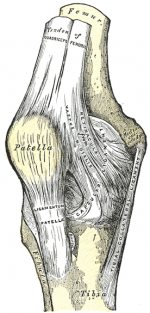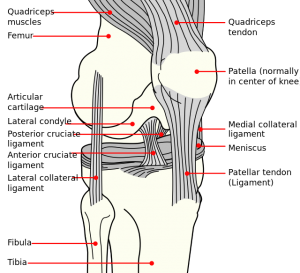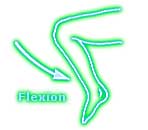Knee: Difference between revisions
Elvira Muhic (talk | contribs) No edit summary |
Elvira Muhic (talk | contribs) No edit summary |
||
| Line 6: | Line 6: | ||
<br> | <br> | ||
= | = Anatomy of the Knee = | ||
== | == Bones == | ||
[[Image:Gray345.png|right|150px]] | [[Image:Gray345.png|right|150px]] | ||
| Line 16: | Line 16: | ||
The thigh bone ([http://www.physio-pedia.com/Femur Femur]), the shin bone ([http://www.physio-pedia.com/Tibia Tibia]) and the kneecap ([http://www.physio-pedia.com/Patella Patella]) articulate through tibiofemoral and patellofemoral joints. These three bones are covered in articular cartilage which is an extremely hard, smooth substance designed to decrease the friction forces. The patella lies in an indentation of the femur known as the intercondylar groove. | The thigh bone ([http://www.physio-pedia.com/Femur Femur]), the shin bone ([http://www.physio-pedia.com/Tibia Tibia]) and the kneecap ([http://www.physio-pedia.com/Patella Patella]) articulate through tibiofemoral and patellofemoral joints. These three bones are covered in articular cartilage which is an extremely hard, smooth substance designed to decrease the friction forces. The patella lies in an indentation of the femur known as the intercondylar groove. | ||
The smaller shin bone that runs alonside the tibia (Fibula) is not directly involved in the knee joint<ref>Keith L. Moore. Clinically Oriented Anatomy 6e edition. P 634</ref>, but provides a surface for important muscles and ligaments to attach to. | The smaller shin bone that runs alonside the tibia (Fibula) is not directly involved in the knee joint<ref>Keith L. Moore. Clinically Oriented Anatomy 6e edition. P 634</ref>, but provides a surface for important muscles and ligaments to attach to. <br> | ||
== The Menisci == | |||
The medial meniscus appears ‘C’ shaped while the lateral meniscus appears more ‘O’ shaped. The surface of each meniscus is concave superiorly, providing a congruous surface to the femoral condyles and is flat inferiorly to accompany the relatively flat tibial plateau. The medial meniscus is much less mobile during joint motion than the lateral meniscus owing in large part to its firm attachment to the knee joint capsule and medial collateral ligament (MCL). On the lateral side the meniscus is less firmly attached to the joint capsule and has no attachment to the lateral collateral ligament. In fact, the posterior horn of the lateral meniscus is separated | |||
[[Image:Lat.meniscus.gif|thumb|right|300px|Knee Menisci]] | |||
<br> | entirely from the posterolateral aspect of the joint capsule by the tendon of the popliteus muscle as it descends from the lateral epicondyle of the femur<ref>Dr. Michael D. Chivers. Anatomy and physical examination of the knee menisci: a narrative review of the orthopedic literature. JCCA 2009. (level A1)</ref>.<br> | ||
== | == Joint capsule == | ||
== Ligaments == | |||
[[Image:Knee ligaments.png|thumb|right|300px|Knee Ligaments]]The ligaments of the knee maintain the stability of the knee. Each ligament has a particular function in helping to maintain optimal knee stability. | |||
< | #'''Medial Collateral Ligament''' (MCL) - This band runs from the medial epicondyle of the femur to the medial condyl and the superior part of the medial surface of the tibia. In the middle of the ligament the deep fibers are attached to the medial meniscus<ref>Keith L. Moore. Clinically Oriented Anatomy 6e edition. P 636</ref>. MCL resists forces acting from the outer surface of the knee, valgus forces. | ||
#'''Lateral Collateral Ligament''' (LCL) – a cord like ligament that begins on the lateral epicoondyle of the femur to the lateral surface of the fibula head. It resists impacts from the inner surface of the knee, varus forces. | |||
<br> | #'''Anterior Cruciate Ligament''' (ACL) - The ACL is one of the most important structures in the knee. The cruciate ligaments are so called because they form a cross in the middle of the knee joint. The ACL, runs from the anterior of the tibia to the posterior of the femur and prevents the tibia moving forward. It is most commonly injured in twisting movements<ref>Lam MH et al. Knee rotational stability during pivoting movement is restored after anatomic double-bundle anterior cruciate ligament reconstruction. Am J Sports Med. 2011. (level b)</ref>. | ||
#'''Posterior Cruciate Ligament''' (PCL) - This ligament runs from the posterior surface of the tibia to the anterior surface of the femur and so wraps around the ACL. The PCL limits anterior rolling of the femur on the tibial plateau during extension<ref>Shingo Fukagawa. Posterior Displacement of the Tibia Increases in Deep Flexion of the Knee. 2009. (level C)</ref>.<br> | |||
<br> | <br> | ||
== | == Muscles and Tendons == | ||
{| cellspacing="1" cellpadding="1" width="40%" border="0" align="right" | {| cellspacing="1" cellpadding="1" width="40%" border="0" align="right" | ||
Revision as of 10:19, 29 July 2016
Original Editor - Rachael Lowe
Top Contributors - Elvira Muhic, Rachael Lowe, Admin, Laura Ritchie, WikiSysop, Simisola Ajeyalemi, Michelle Lee, Kim Jackson, Andeela Hafeez, Leana Louw, Evan Thomas, Scott Buxton, Bert Lasat, William Jones, Eric Robertson, Joao Costa, Kristen Mason, Blessed Denzel Vhudzijena, George Prudden, 127.0.0.1, Tony Lowe, Vidya Acharya, Rucha Gadgil, Ernest Gamble, Jess Bell, Sai Kripa and Aminat Abolade
Anatomy of the Knee[edit | edit source]
Bones[edit | edit source]
The knee joint is one of the largest and most complex joints in the body. It is constructed by 4 bones and an extensive network of ligaments and muscles.
The thigh bone (Femur), the shin bone (Tibia) and the kneecap (Patella) articulate through tibiofemoral and patellofemoral joints. These three bones are covered in articular cartilage which is an extremely hard, smooth substance designed to decrease the friction forces. The patella lies in an indentation of the femur known as the intercondylar groove.
The smaller shin bone that runs alonside the tibia (Fibula) is not directly involved in the knee joint[1], but provides a surface for important muscles and ligaments to attach to.
The Menisci[edit | edit source]
The medial meniscus appears ‘C’ shaped while the lateral meniscus appears more ‘O’ shaped. The surface of each meniscus is concave superiorly, providing a congruous surface to the femoral condyles and is flat inferiorly to accompany the relatively flat tibial plateau. The medial meniscus is much less mobile during joint motion than the lateral meniscus owing in large part to its firm attachment to the knee joint capsule and medial collateral ligament (MCL). On the lateral side the meniscus is less firmly attached to the joint capsule and has no attachment to the lateral collateral ligament. In fact, the posterior horn of the lateral meniscus is separated
entirely from the posterolateral aspect of the joint capsule by the tendon of the popliteus muscle as it descends from the lateral epicondyle of the femur[2].
Joint capsule[edit | edit source]
Ligaments [edit | edit source]
The ligaments of the knee maintain the stability of the knee. Each ligament has a particular function in helping to maintain optimal knee stability.
- Medial Collateral Ligament (MCL) - This band runs from the medial epicondyle of the femur to the medial condyl and the superior part of the medial surface of the tibia. In the middle of the ligament the deep fibers are attached to the medial meniscus[3]. MCL resists forces acting from the outer surface of the knee, valgus forces.
- Lateral Collateral Ligament (LCL) – a cord like ligament that begins on the lateral epicoondyle of the femur to the lateral surface of the fibula head. It resists impacts from the inner surface of the knee, varus forces.
- Anterior Cruciate Ligament (ACL) - The ACL is one of the most important structures in the knee. The cruciate ligaments are so called because they form a cross in the middle of the knee joint. The ACL, runs from the anterior of the tibia to the posterior of the femur and prevents the tibia moving forward. It is most commonly injured in twisting movements[4].
- Posterior Cruciate Ligament (PCL) - This ligament runs from the posterior surface of the tibia to the anterior surface of the femur and so wraps around the ACL. The PCL limits anterior rolling of the femur on the tibial plateau during extension[5].
Muscles and Tendons[edit | edit source]
| [6] |
The two main muscle groups of the knee knee joint are the quadriceps and the hamstrings.
• M. Quadriceps
• M. Biceps femoris
• M. Semimembranosus
• M. Semitendinosus
• M. Gracilis
• M. Sartorius
• M. Triceps Surae
• M. Plantaris
Function:[edit | edit source]
Motions Available:[edit | edit source]
Flexion and extension are the main movements. There is a little rotation when the knee flexes.
| [7] | [8] |
Range of motion[edit | edit source]
extension:0 degree flexion:140
Closed Packed Position:[edit | edit source]
Near full extension. There is a medial rotation of the femoral condyles on the tibial plateau[9].
Open Packed Position:[edit | edit source]
Midrange flexion[10].
Clinical Examination[edit | edit source]
- Knee Examination
- Special Tests
- Outcome Measures
Conditions
[edit | edit source]
- Anterior Cruciate Ligament Injury
- Articular Cartilage Lesions
- Baker's Cyst
- Chondromalacia Patellae
- Femoral Fractures
- Hamstring Strain
- Iliotibial Band Syndrome
- Knee Osteoarthritis
- Knee Bursitis
- Lateral Collateral Ligament Injury
- Medial Collateral Ligament Injury
- Meniscal Lesions
- Ober's Test
- Osteochondritis Dissecans of the Knee
- Osgood-Schlatter's Disease
- Plica Syndrome
- Quadriceps Muscle Strain
- Quadricpes Muscle Contusion
- Patellofemoral Pain Syndrome
- Patellofemoral Instability
- Patellar Tendinitis
- Patellar Fractures
- Pes Anserinus Bursitis
- Plica Syndrome
- PrePatellar Bursitis
- Popliteus Tendinitis
- Posterior Cruciate Ligament Injury
- Sinding Larsen Johansson Syndrome
- Tibial Plateau Fractures
Procedures
[edit | edit source]
- Arthroscopic Meniscectomy
- Meniscal Repair
- Articular Cartilage Debridement & Microfracture
- ACL Reconstruction
- Patellar Tendon Autograph
- Hamstring Tendon Autograph
- Allograph
- Patellar Tendon Autograph
- PCL Reconstruction
- ORIF Post-Fracture
- Arthroscopic Debridement & Manipulation
- Lateral Release of the Patella
- Tibial Osteotomy
Interventions[edit | edit source]
Recent Related Research (from Pubmed)[edit | edit source]
Reference[edit | edit source]
- ↑ Keith L. Moore. Clinically Oriented Anatomy 6e edition. P 634
- ↑ Dr. Michael D. Chivers. Anatomy and physical examination of the knee menisci: a narrative review of the orthopedic literature. JCCA 2009. (level A1)
- ↑ Keith L. Moore. Clinically Oriented Anatomy 6e edition. P 636
- ↑ Lam MH et al. Knee rotational stability during pivoting movement is restored after anatomic double-bundle anterior cruciate ligament reconstruction. Am J Sports Med. 2011. (level b)
- ↑ Shingo Fukagawa. Posterior Displacement of the Tibia Increases in Deep Flexion of the Knee. 2009. (level C)
- ↑ ladyrain9. Knee Muscles. Available from: http://www.youtube.com/watch?v=ZIcqGUwT4oQ [last accessed 21/09/14]
- ↑ Anatomy Zone. Knee Joint - Part 1 - 3D Anatomy Tutorial. Available from: http://www.youtube.com/watch?v=ve448qTT_-4 [last accessed 21/09/14]
- ↑ Anatomy Zone. Knee Joint - Part 2 - 3D Anatomy Tutorial. Available from: http://www.youtube.com/watch?v=58g4nWqbHAc [last accessed 21/09/14]
- ↑ Lentell G. The effect of knee position on torque output during inversion and eversion movements at the ankle. J Orthop Sports Phys Ther. 1988.
- ↑ Lentell G. The effect of knee position on torque output during inversion and eversion movements at the ankle. J Orthop Sports Phys Ther. 1988.











